Sateré Mawé
- Self-denomination
- Where they are How many
- AM 16312 (Siasi/Sesai, 2020)
- Linguistic family
- Mawé
Inventors of the guaraná culture, the Sateré-Mawé domesticated this wild vine and created its processing method, thanks to which guaraná is known and consumed all over the world.
Name
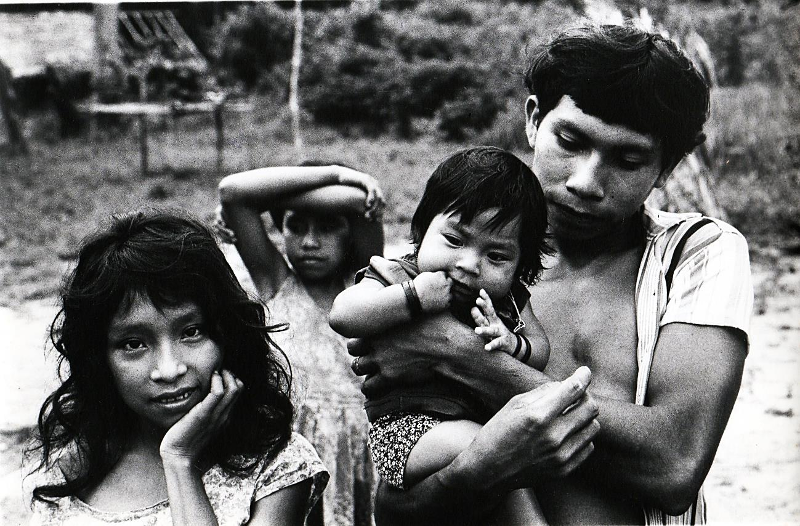
The Sataré-Mawé are called simply Mawés in the region. They have been called several names, given by chroniclers, pioneers, missionaries and naturalists: Mavoz, Malrié, Mangnés, Mangnês, Jaquezes, Magnazes, Mahués, Magnés, Mauris, Mawés, Maragná, Mahué, Magneses, Orapium.
They call themselves Sateré-Mawé. The first word, Sateré, means “burning caterpillar”, a reference to their society’s most important clan, the one that traditionally appoints the succeeding line of the group’s political chief. The second word, Mawé, means “intelligent and curious parrot” and is not a clan designation.
Language
The Sateré-Mawé language is part of the Tupi linguistic branch. According to ethnographer Curt Nimuendaju (1948), it differs from the Guarani-Tupinambá. Pronouns are the same as those of the Curuaya-Munduruku language, and the grammar is, it seems, Tupi. But the Mawé vocabulary contains elements that are entirely different from Tupi, and cannot be related to any other linguistic family. Since the 18th Century their repertoire includes many words from the Língua Geral (the language spoken in colonial Brazil until the late 18th Century, a mixture of Indians languages and Portuguese).
Today most Sateré-Mawé men are bilingual – they speak their own language and Portuguese; women, on the other hand, tend to speak only Sateré-Mawé, despite this people’s three centuries of exposure to the national society.
Location
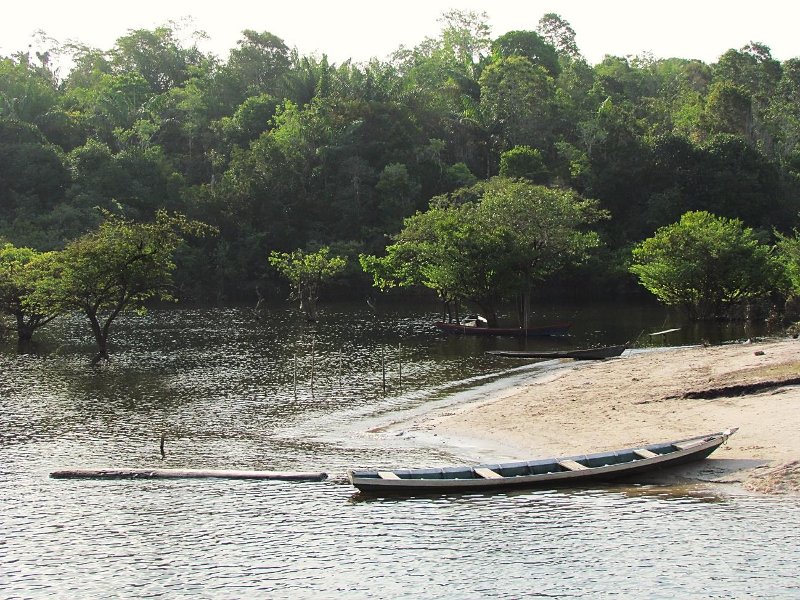
The Sateré-Mawé live in the region of the mid Amazon River, on the border of the States of Amazonas and Pará. The Andirá-Marau Indigenous Land was demarcated in 1982 and ratified in 1986. With a total area of 788,528 hectares, it is located in the municipalities of Maués, Barreirinha, Parintins, Itaituba e Aveiro, situated in both States.
Demography
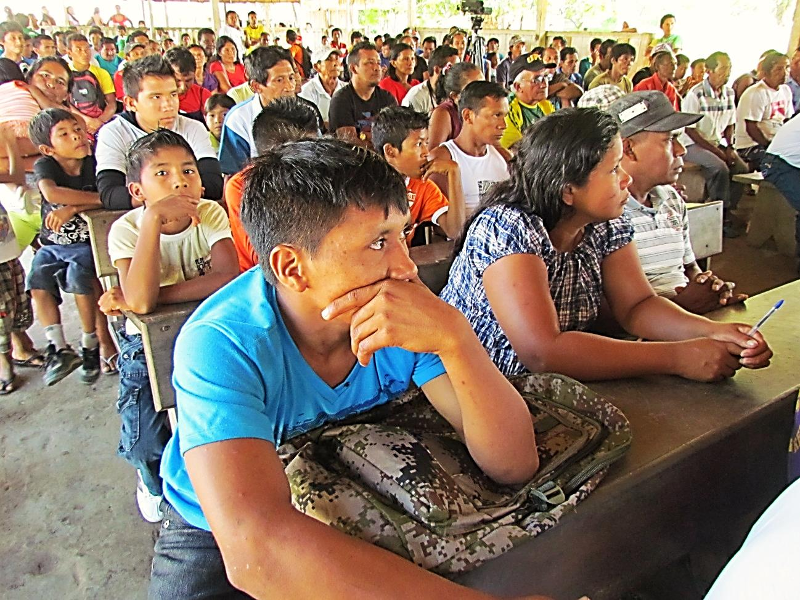
According to a Funai (Fundação Nacional do Índio – National Foundation for the Indian, the official organ for Indian policy in Brazil) estimate, the Sateré-Mawé were 4,710 in 1987. Since 1981 there has been considerable population growth. More recent data by Funasa (Fundação Nacional da Saúde – National Health Foundation) and by the NGO Ameríndia Cooperação indicate 3,872 inhabitants in the Andirá area (where there are 42 villages) and 3,078 in the Marau area (with 31 villages). Thus in 1999 the Satere-Mawé’s total population was 6,950.
<thead> </thead>
| Year | Population | Source |
|---|---|---|
| 1987 | 4710 | Funai |
| 1991 | 5825 | Funai |
| 1999 | 6950 | Ameríndia Cooperação |
| 2000 | 7134 | Funai |
| 2002 | 7376 | Funasa |
| 2010 | 10761 | Funasa |
| 2014 | 13350 | CGTSM |
It should be pointed out that, from the 1970s on, the migratory movement towards Manaus increased. In 1981, the anthropologist Jorge Osvaldo Romano counted 88 Sateré-Mawé living in poor neighborhoods of the city’s outskirts. By the end of the 1990s, the number had grown significantly, and some 500 Sateré-Mawé lived in different housing projects in Manaus’ western edge. This urban population survives, in most cases, thanks to the sale of arts and crafts to tourists.
Territory and history of the contact with the whites
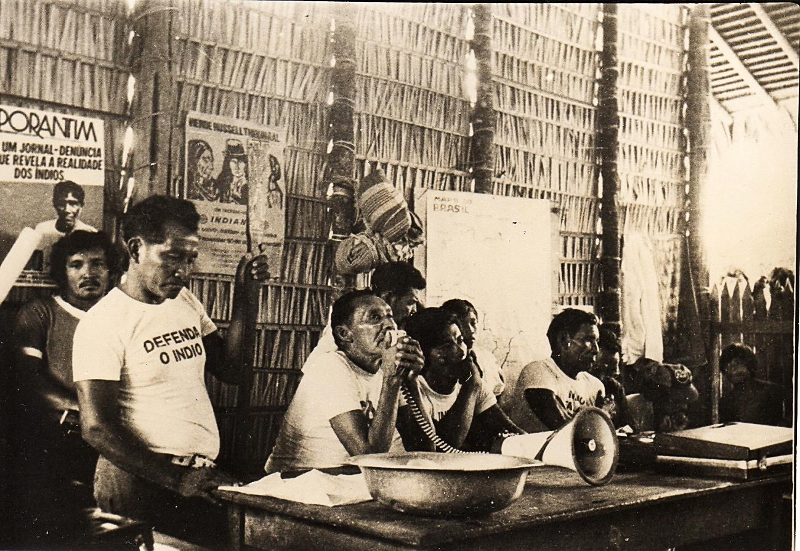
According to the older Sateré-Mawé, their people’s ancestors lived in ancient times in the vast area between the Madeira and Tapajós rivers, limited to the north by the Tupinambaranas islands, on the Amazon River, and, to the south, by the Tapajós headwaters.
The Sateré-Mawé refer to their place of origin, where their mythical heroes live, by the name of Noçoquém. It is located on the left bank of the Tapajós, in a rocky region of dense forest, where the rocks speak.
Nunes Pereira, who lived with the Sateré-Mawé people in the 1950s, recalls that the lakes and rivers teeming with fish that irrigate the lands where the Maués lived in the past, as well as the forests and campinaranas rich in every kind of prey, must have constituted, in a more remote epoch, a magnificent landscape for the activities of this people. To the pantheist representation of the Noçoquem – the place where all plants and animals useful to the Maués are found, according to the Guaraná Legend –, should correspond, in the past, the territory they once occupied.
The Sateré-Mawé had their first contact with whites when Jesuits founded the Tupinambaranas Mission, in 1669. According to Bettendorf, "in 1698 the Andirá received Father João Valladão as missionary. It is impossible to locate the Maraguá with precision, but they lived on a lake, between the Andirá and Abacaxi rivers, probably on the lower Maués-Açu, which spreads out to form a kind of lake. They lived in three villages close to each other" (1910:36). In 1692, after they killed a few white men, the colonial government declared just war (legal) against them, which was partially avoided by the Indians because, informed in advance, most of them ran away, so that only a few offered resistance.
From the time of contact with the whites – and even before that, due to the wars against the Munduruku and Parintintim –, the Sateré-Mawé’s ancestral territory has been considerably reduced. When Amazonia’s most important insurrection against the central government after the independence of Brazil, the Cabanagem, erupted in 1835, the Munduruku, the Mawé (from the Tapajós and Madeira rivers) and the Mura (from the Madeira River), along with the indigenous groups of the Negro River, joined the cabanos rebels, and surrendered only in 1839. Epidemics and atrocious persecution against the indigenous groups that sided with the insurgent devastated huge areas of the Amazon Region, either forcing these Indians out of their traditional territories or reducing them.
Voyagers’ reports confirm that there has been indeed a territorial reduction from the 18th Century on, and mention the area between the rivers Marmelos, Sucunduri, Abacaxis, Parauari, Amana and Mariacuã as the Sateré-Mawé’s traditional territory. These reports confirm also that the cities of Maués and Parintins, in the State of Amazonas, and Itaituba, in Pará, were built atop Sateré-Mawé sites, which coincide with passages of this people’s oral history.
Thinking in terms of macro-territory, the occupation of the Amazon Region by the “civilizados” (civilized) – the word the Sateré-Mawé use to designate all those who are neither Sateré-Mawé (i.e., caboclos, or mestizos, whites, foreigners) nor belong to another Indian group –, has significantly reduced their traditional territory. First it was military and the Jesuit and Carmelite missions; later came the economic cycle of forest products; next, rubber extraction; and finally the expansion of the cities of Maués, Barreirinha, Parintins and Itaituba into their hinterland, with the establishment of farms, the extraction of pau-rosa (rosewood) and the opening of mineral prospecting fields, as well as the control of the Indian’s economy through the regatões (merchants that ply the rivers of the Amazon Region).
In 1978, when the demarcation process of the Sateré-Mawé territory began, the villages, sites, roças, cemeteries and the territories used for hunting, fishing, gathering and roaming were located between and, in the vicinity of, the Marau, Miriti, Urupadi, Manjuru and Andirá rivers. The Sateré-Mawé considered that area theirs, although they were aware that it was no more than a small portion of what had been their traditional territory. For them, a privileged part of their territory had been kept.
The Sateré-Mawé have traditionally been forest Indians – Indians of the center, as they themselves say. Until the beginning of the 20th Century they chose regions in the middle of the forest, near the headwaters of rivers, to build their villages and plant their fields. In these areas animals for hunting are abundant; the filhos de guaraná (children of guaraná, as they call, in Portuguese, the native saplings of Paullinia sorbilis) are common; there are large numbers of palm trees such as açaí, tucumã, pupunha and bacaba, which are seasonally part of the diet; the rivers are narrow igarapés, with rapids and cool waters. This is the Sateré-Mawé ecosystem par excellence; and the villages that still keep traditional ways, “like in the old times” (the spatial distribution, the architecture, the roças, the rituals etc.), are located in such areas.
The characteristics of those ecological niches were essential for the reproduction of the Sateré-Mawé’s traditional ways until the beginning of the 20th Century. According to the older Indians, the old villages of Araticum Velho and Terra Preta, both located on the headwaters of the Andirá River, were the foci the 42 villages that currently exist along this river originated from. Likewise, the village of Marau Velho, on the headwaters of the Marau River, was the initial nucleus of the 31 villages found today on that river, as well as of the villages found along the Miriti, Manjuru and Urupadi rivers. Those three villages disappeared in the 1920s, but the signs of their existence can still be seen in the capoeira.
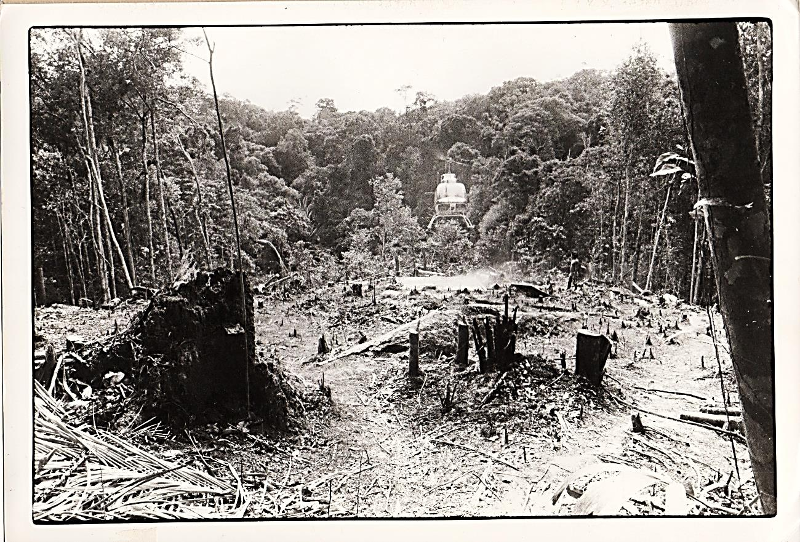
The proliferation of villages along the Marau and Andirá rivers has been happening for approximately 80 years, and is attributed to the interferences on the Sateré-Mawé traditional ways by religious missions, by the now-defunct SPI and by present-day Funai, as well as by the pressure from the regatões and by epidemics. All these factors led the Sateré-Mawé to want to be near the cities of Maués, Barreirinha and Parintins.
Political organization
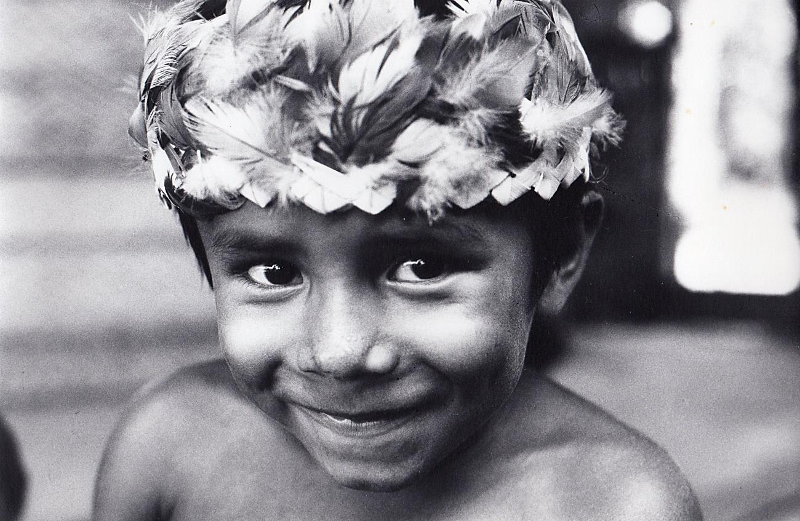
Every village has a tuxaua, who has the power of solving internal conflicts and quarrels, summoning meeting, scheduling celebrations and rituals, defining the agricultural activities and commercial transactions, ordering the building of houses etc. The tuxaua is in charge of hosting guests, demonstrating his generosity and carrying out the ceremonial role of offering çapó – guaraná sticks grated in water, a beverage drunk in large quantities daily that also has ritual and religious functions.
Like any chief of an extensive family, the tuxaua is in charge of managing the interests of his family, a responsibility that he takes very seriously, especially in what refers to solving quarrels and defining agricultural and commercial activities. He also manages the interests of the other extensive families and family units that live in his village, but in these cases in a more flexible manner.
In this sense, it is possible to say that the village’s smallest constitutive unit is always the tuxaua extensive family. The village may be comprised also of this family plus other family units, or by a set of extensive families, whose chiefs are subjected to the influence of the local tuxaua.
The tuxaua’s political authority may transcend the village limits, depending on his performance as chief, on his relationship with the other Sateré-Mawé tuxauas and, especially, with the general tuxaua.
One can observe that nowadays a tuxaua’s degree of political influence depends on various criteria, among them: the clan to which he belongs, his kinship relations and the prestige he has with the other tuxauas, his knowledge of old times (Sateré-Mawé history and mythology), his speaking ability, how generous he is, his tradition as a planter and processor of guaraná, his commercial abilities, the way in which he conducts his community’s internal affairs and the quality of his relations with the surrounding society, particularly the Funai, the bosses and the local politicians. It is possible to say that the general tuxaua is a chief who ranks well in all those areas.
In addition to the chiefs of extensive families, of the tuxauas and of the general tuxauas, in the Sateré-Mawé political organization there is room also for the figure of the capitão (captain), introduced by the SPI – Serviço de Proteção ao Índio (Service of Protection for the Indian), Brazil’s first official organ for Indian affairs – and reinforced by the Funai. The capitão’s role is to make the interface between the Sateré-Mawé and the whites – more specifically, to serve as bridge between his society’s traditional leaders with the national society authorities.
The capitão interacts especially with outside authorities: the head of the Indigenous Post, the sheriff and the Funai’s superintendent and its president, as well as mayors, priests and preachers. Often it is these agents of the State and of religious congregations present in the area that choose the person who will be the capitão, who is then manipulated according to their interests. This, in addition to the fact that he is not a traditional leader, makes the capitão a controversial figure in the Sateré-Mawé political life.
Social and economic organization
The areas in which the Sateré-Mawé live are called sítio. In this space each family unit has its residence, where a fire is lit both for cooking and for keeping the residents warm (the fire also serves to congregate the family members around it). In their sítios families also have their kitchen, built halfway between the house and the river, where the men roast guaraná and the women prepare manioc meal. They also have their porto (port), as they call the site on the river or igarapé (small Amazon waterway) where the family members bathe, wash clothes, soak cassava, wash guaraná and land their canoes.
Sítios congregate all the family unit’s fields: the guaraná fields and the roças (planting fields) of cassava, pumpkin, yam, sweet potatoes, as well as the orchards.
The Sateré-Mawé are organized under the authority of the chief of the extensive family, who lives in his sítio along with his children’s and grandchildren’s families. He organizes the sítio’s production, determining his sons’ and his sons-in-law’s economic activities. It is he who invites relatives and friends from other sítios or villages to come help the work, when needed, gathering them in the puchiruns. In those occasions, he orders hunting and fishing expeditions, as well as the roasting of manioc meal, in order to provide food for those who participate in these collective labor activities. During the puchiruns, he follows the work closely: the clearing of the cassava and guaraná roças, the weeding of the guaraná fields, as well as the processing of guaraná.
The chief of the extensive family may order houses to be built, determine the clearing of a given area – which the Sateré-Mawé call faxina (Portuguese for clean up) –, send people in gathering expeditions. He also assists in the sale of his relatives’ agricultural and manufacturing production.
Sítios are, therefore, private domains, in which the land and the other natural resources are taken by family units, which submit themselves to the authority of the chief of the family group, traditionally regarded as its owner.
Thus the sítio is the local group latu sensu, the basic unit of the Sateré-Mawé political and economic organization. It may become a village when the number of family units increases or when, independently from this, its chief starts to be regarded as a tuxaua (chief). This may take place if he is recognized for his generosity, or his abilities in commercial transactions, or his good rapport with the closest tuxauas or with the general tuxaua.
Currently, the layout of most Sateré-Mawé villages is similar to that of the small towns in the region. It is in the villages that are located the houses of the family units, their kitchens and ports, as well as churches of different denominations, the school and the infirmary. As in the sítios, in the vicinity of the villages located the cassava roças, the guaraná fields, the orchards and the other planted areas that belong to each family unit.
The children of guaraná
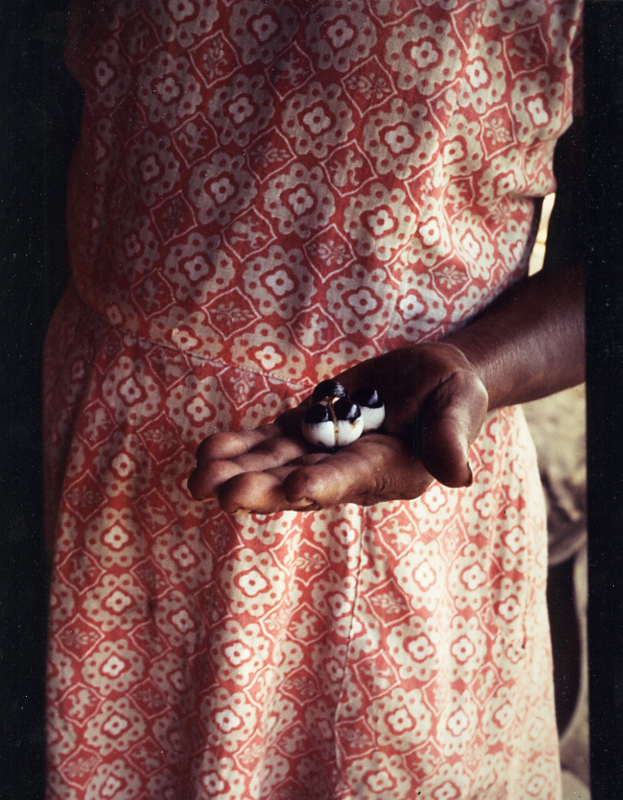
Inventors of the Guaraná culture, the Sateré-Mawé have transformed the Paullinia cupana, a wild vine of the Sapindacea family, into a cultivated shrub, and mastered its planting and processing. Guaraná is a plant native to the highlands of the Maués-Açu River basin, which coincide precisely with the Sateré-Mawé traditional territory.
The Sateré-Mawé see themselves as the inventors of the plant’s culture, a self-image justified on the ideological level through their myth of origin, according to which they are the Children of Guaraná.
Guaraná is the main ingredient of the Sateré-Mawé economy par excellence. It is, among the items they produce commercially, the most valuable in the market. One may speculate that the vocation for commerce showed by the Sateré-Mawé is explained by the importance of the guaraná in their social and economic organization.
The first description of guaraná and its importance for the Sateré-Mawé dates of the year the group first had contact with whites. Thus Father João Felipe Betendorf described, in 1669, that "the Andirazes have in their woods a small fruit they call guaraná, which they dry and then press with the feet and make balls with, and which they praise like whites praise their gold, and which, grated with a small rock and drunk mixed with water from a gourd, provides them with so great a strength that when the Indians go hunting they do not feel hungry and in addition it makes one urinate and cures fever, headaches and cramps".
In 1819, the naturalist Carl von Martius brought from the Maués region a sample of guaraná, which he named Paullinia sorbilis. Von Martius observed that there existed an intense guaraná trade, which spread it to distant places such as Mato Grosso and Bolivia. In 1868 Ferreira Pena wrote: Each year merchants from Bolivia e Mato-Grosso sail down the Madeira to Serpa and Vila Bela Imperatriz, to where they bring their export products and where they receive the import ones. From there, before they go back, they go to Maués, from where they take 1,000 arrobas (arroba is an old Portuguese weight measure of weight, equivalent to 15 kilos) of guaraná, returning then on ubás (dugout canoes) loaded with goods and of guaraná, which they sell in the departments of Beni, Santa Cruz de la Sierra and Cochabamba, in Bolivia, and in the settlements along the Guaporé River and its tributaries.
Guaraná trade has always been intense in the Maués region, and not only involved the Sateré-Mawé, but also by the civilized. The popularity of guaraná is due to its properties as stimulant, intestinal regulator, anti-venereal disease, cardiovascular tonic and aphrodisiac. It is as a stimulant after being processed that guaraná is most popular, because of its high level of caffeine (between 4 and 5%), higher than tea (2%) and coffee (1%).
There is a distinction between the high-quality, Sateré-Mawé processed guaraná – known as guaraná das terras (lands guaraná), guaraná das terras altas (highlands guaraná) or guaraná do Marau (Marau guaraná) – and the guaraná processed by the civilized in the Maués region, called guaraná de Luzéia (Luzéia guaraná, referring to the city of Maués’ former name), of lower quality because it is produced without the knowledge and the care of the Indians’ traditional practices. The guaraná from the indigenous lands has always been the most looked after.
Gender and age division of labor
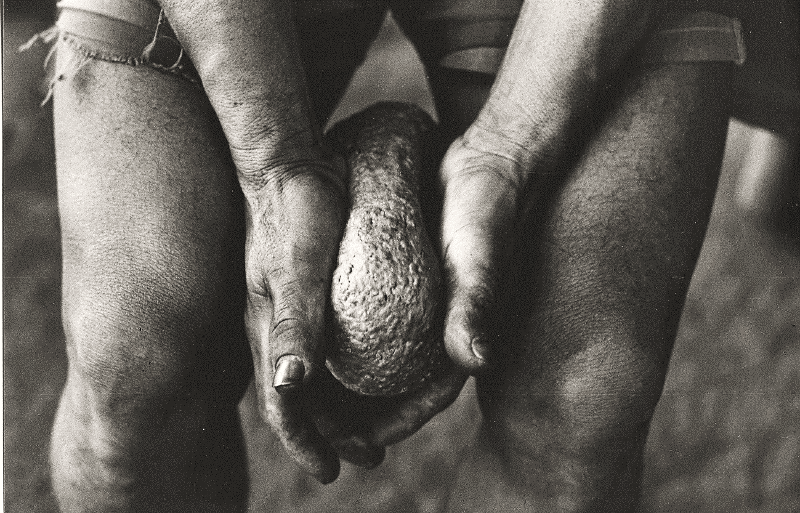
The fábrico process is a predominantly masculine productive cycle. We observe that there is a relation between the gender and the age division of labor. The Sateré-Mawé society prescribes for the simpler activities of the fábrico process – those that do not depend so much of art and experience – hands of different ages. But when it comes to more sophisticated tasks, we always find adult or aged hands taking care of the guaraná.
The juxtaposition of gender and age results in that the harvesting of the branches, the peeling of the raw guaraná, the washing of the guaraná, the roasting, the peeling of the roasted guaraná and the crushing are almost exclusively masculine tasks, spanning age groups from boys to adults. Women participation occurs only in the peeling of raw and roasted guaraná, activities that are considered very simple. period, because after that they earn the social status of adult women, becoming potential wives and mothers.
It is the three last activities of the fabrico process that demand the most care, since they have a direct effect on the quality of the final product, the guaraná sticks. That is why the preparation of the loaves, their washing and their smoking are carried out exclusively by adults or aged men. According to the prescriptions of gender and age division of labor, only them men can be charged with the preparation of the guaraná loaves and the control of the smoking process.
The washing of the guaraná loaves is clearly different from the other activities of the fábrico because it is the only moment in the process in which women actually take part. The Sateré-Mawé society prescribes that only the adult women (mothers) or aged (grandmothers) receive from the baker, after a brief rest on the banana tree stalks, the still fresh, tender, brown loaves of guaraná to be extensively and carefully washed.
The washing of the guaraná loaves is unquestionably the most delicate task in the fabrico process, which is not enough to explain the female incursion into an eminently male universe.
The break of a taboo that is the entry of the women (who already have had their periods and have husbands, children and grandchildren) in the fábrico process in such a determined way can only be understood through the myths.
In short, women are represented in the Sateré-Mawé mythical corpus by the female figures Uniaí, Onhiámuáçabê and Unhanmangarú, who at times are sisters of Anumaré (God), at times sisters of Ocumaató and Icuaman (twin brothers). Those mythical women have a wide range of attributes and prerogatives that have resonance in the Sateré-Mawé social life, even if in an inverted or opposite way.
It is by following this path that we can understand the participation of the women in the fabrico process, precisely in the washing of the guaraná loaves, since they hold the position of Onhiámuáçabê in the "History of Guaraná – the female shaman, wife and mother. Onhiámuáçabê, through shamanistic practices, whose central theme is the washing of her son’s dead body with her saliva and with the juice of magic plants, causes the appearance of the first guaraná plant, starting agriculture, reviving her son – the first Sateré-Mawé –, and founding society.
It is interesting to note that in the Sateré-Mawé society, the role of pajé (shaman) is exclusively masculine, in opposition to some of its myths, in which this role is reserved to women. Likewise, social life reserves to men the task of processing the guaraná, while in the myths it is the women who are in charge of it. It is probably those inversions that make possible the break of the taboo in the gender division of labor in the fabrico process, leaving for the women the continuity of their mythical functions in social life.
Preparation and consumption of guaraná
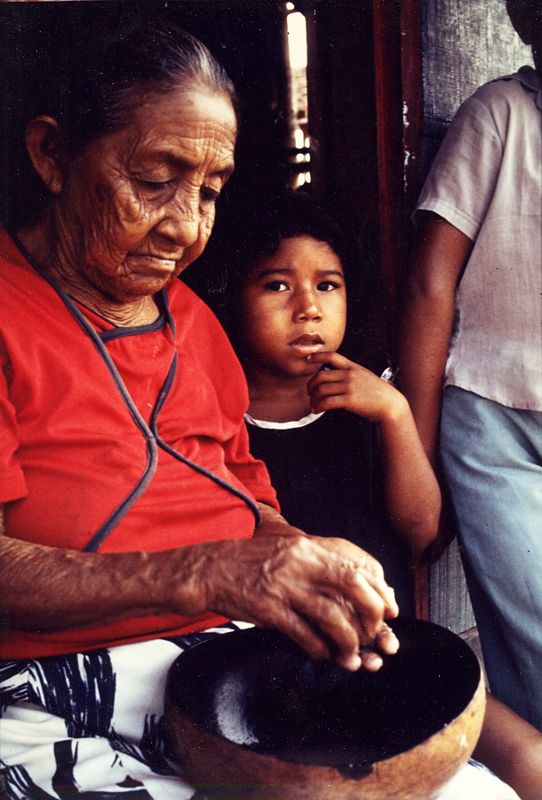
The çapo – guaraná in stick grated in water –, is the daily, ritual and religious beverage, and is drunk in large quantities by adults and children alike. Çapó preparation and consumption follow a series of practices that make up a veritable ritual. The nature of the ritual of guaraná drinking is, however, different from that of a formal ritual, such as the Tocandira Festival or the reading of the Porantim.
Anthony Henman described thus a çapó session: "Such practices are essentially the same in all circumstances, whether the çapó is prepared for the smallest family circle or for all adult males during a festival or a political meeting. It is the host’s wife’s responsibility to grate the guaraná, an operation for which is used the tongue of a pirarucu [a very large Amazon fish] or a smooth square basalt rock. An open gourd of the species Crescentia cujete is placed atop a support called patauí and filled with water up to one fourth of its total capacity. The action of ‘grating’ the wet guaraná is not designed to turn the stick into powder, such as with dry guaraná. Instead, the idea is to turn the guaraná into a kind of goo, which adheres to the grating instrument and to the stick and is periodically dissolved by the woman who is doing the grating by her dipping the fingers in the water.
Once it is prepared, the çapó is again diluted in water set aside by the guaraná ‘owner’ [the grating woman] in a gourd of the species Lagenaria siceraria. The gourd is by now more than half full with çapó, and is then handed by the woman to her husband, who takes just a small sip before passing it on to the others, normally giving preference to older people or to an important visitors, if there are any. The gourd is then passed from person to person according to the physical proximity of the participants rather than following a rigid hierarchical scheme. In evening sessions, a large tobacco cigar rolled in a tree bark accompanies the guaraná drinking. The name tauarí is used for the cigar, for the bark proper and for the tree itself (Couratari tauary).
It is not always that the gourd and the tauarí make a circular round. It is more common that they are passed on a straight line from one participant to another, returning on the same line until going back to the owner. When too many people are present, two or more lines are formed, since a single gourd is rarely consumed by more than eight or ten people. The participant who does not feel like drinking guaraná does not refuse the offer, but instead keeps the formalities by drinking a small sip so as to not offend the host. Another important detail is that no one ever drinks the last drop in the gourd – no matter how little he gets, he will make sure there will be at least a little left for the host. He is the only one with the right to formally close the çapó session, which he may do personally or by passing on what is left to a family member with the phrase ‘wai'pó’ (‘here’s the tail’).
While the gourd circulates among the present, the host’s wife continues to scrub the guaraná stick on the grater, forming the goo that will be promptly dissolved into water as soon as the gourd returns to her hands. (1983:26-27)
Each çapó session has several rounds of the drink. That means that the host’s wife (or his daughter or granddaughter) prepares several gourds of çapó, according to the desire of the visitors or family members to drink çapó and talk.
Çapó is the beverage the Sateré-Mawé women drink when they are in their period, pregnant, after giving birth and in mourning. Men drink it in the Tocandira Festival, in mourning and after their wives give birth.
One can say that it is during the fábrico, a regional term also used by the Sateré-Mawé to indicate the various stages of guaraná processing, that social life intensifies. From what we have observed, the fábrico process to bring to the maximum the society’s way of life, bringing to the daily social life a full range of phenomena that remain occult or obscure in the other times of the year. It is a period that renews itself each year with the arrival of the guaraná harvest, allowing the Sateré-Mawé to partake their mythical genesis, reinvigorating them ethnically.
The Tocandira ritual coincides with the season of the fábrico process and last about 20 days. The Indians refer to this ritual as “to stick the hand into the glove”, also known by the regionals as the Festa da Tocandira (Tocandira Festival). It is a rite of passage – in which boys become men – of extraordinary importance to the Sateré-Mawé, with chants of lyrical exaltation of work and love and epic chants related to war. The gloves used in this ritual are made of straw painted with genipap and adorned with macaw and hawk feathers; the initiate sticks his hand in them to be bit by dozens of tocandira ants (Paraponera clavata).
Material culture and cosmology
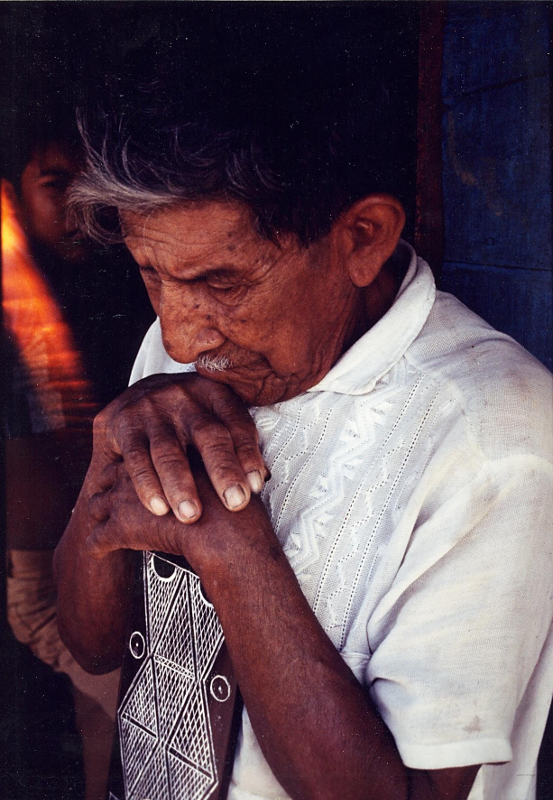
The main expression of the Sateré-Mawé’s rich material culture is the teçume, which is how they call the crafts manufactured by the men with stalks and leaves of caranã, arumã and other Amazon plants, such as sieves, baskets, tipitis (a kind of cylinder used for squeezing the poison out of wild cassava), fans, bags, hats, walls, roofs etc.
Great emphasis is given to the Porantim in the Sateré-Mawé cosmology. The Porantim is a wooden piece about 1.5-meter high, carved with geometric figures in bas relief painted in white, the tabatinga. Its shape resembles a war club or a carved oar. The Porantim has a wide range of attributes: it is the social legislator, and the Sateré-Mawé frequently refer to it as their Constitution or their Bible. It has magical powers, is capable of foreseeing the future and may move around by itself in order to solve internal quarrels and conflicts. It is also where is engraved, on one side, the myth of origin or the history of the guaraná, and, on the other, the myth of war. Thus for the Sateré-Mawé it is the highest institution, representing the political, juridical, magical-religious and mythic spheres.
Sources of information
- AGASSIZ, Luiz; AGASSIZ, Elizabeth Cary. Viagem ao Brasil : 1865-1866. São Paulo : Edusp ; Belo Horizonte : Itatiaia, 1975. 323 p. (Reconquista do Brasil, 12)
- ALANIS, Rosângela. Sateré-Maué apostam na força do guaraná. Amazônia Vinte e Um. Manaus : Vinte e Um, v. 2, n. 7, p. 15-7, abr. 2000.
- ALVAREZ, Gabriel O. Os Satere-Mawé. In: ALVAREZ, Gabriel O.; REYNARD, Nicolas (Org.). Amazônia cidadã : previdência social entre as populações tradicionais da região Norte do Brasil. Brasília : MPAS, 2000. p. 78-95. (Coleção previdência Social, Série Especial, 1)
- -------- Satereria. Tradição e política Sateré-Mawé. Manaus : Valer Editora, 2009. 210 p.
- AZEVEDO, Marta Maria; PAGLIARO, Heloísa; SANTOS, Ricardo Ventura. Demografia dos Povos Indígenas. Rio de Janeiro: Editora Fiocruz, 2005, 192 p.
- BATISTA, Adenise Oliveira et al. Seres vivos. v. 2: nossos peixes, pequenos animais. Manaus : Seduc ; Maues : Opism, 1998. 79 p.
- BAYERN, Therese von. Meine Reise in den Brasilianischen Tropen. Berlim : Verlag von Dietrich Reiner, 1897.
- BERNAL, Roberto Jaramillo. Índios urbanos: processo de reconformação das identidades étnicas indígenas em Manaus. Manaus: Editora da universidade federal do Amazonasqfaculdade Salesaina Dom Bosco, 2009.
- BETENDORF, João Felipe. Crônica da missão dos padres da Companhia de Jesus no estado do Maranhão. Rev. do IHG, Rio de Janeiro : IHG, n. 1, 1910.
- COUDREAU, Henry. Viagem ao Tapajós. São Paulo : Edusp ; Belo Horizonte : Itatiaia, 1977. 166 p. (Reconquista do Brasil, 44)
- FIGUEROA, Alba Lucy Giraldo. Guerriers de l'écriture et commerçants du monde enchanté : histoire, identité et traitement du mal chez les Sateré-Mawé (Amazonie Centrale, Brésil). Paris : EHESS, 1998. 585 p. (Tese de Doutorado)
- FITTIPALDI, Ciça. A lenda do guaraná : mito dos índios Sateré-Maué. São Paulo : Melhoramentos, 1986. 16 p. (Série Morena)
- FRANCESCHINI, Dulce (Org.). Sateré-Mawé : mowe'eg hap. Manaus : Seduc : Maues : Opism : 1997. 105 p.
- -------- (Org.). Satere-Mawe : pusu etiat wemu'e hap. Maués : OPISM, 1997. 96 p.
- GRAHAM, Sue. Sateré Mawé pedagogical grammar. Brasília : SIL, 1995. 38 p. (Arquivo Lingüístico)
- HARTMANN, Tekla. Artefactos indígenas brasileiros em Portugal. Boletim da Sociedade de Geografia, Lisboa : Sociedade de Geografia, Série 100, ns. 1 a 6; 7 a 12, 1982.
- HENMAN, Anthony. O guaraná. São Paulo: Global/ Ground, 1982. (Cadernos de Vida Natural, 10)
- KAPFHAMMER, Wolfgang. Divine Child and Trademark. Economy, morality, and cultural sustainability of a guaraná project among the Sateré-Mawé, Brazil, in: Aparecida Vilaça / Robin M. Wright (eds.) Native Christians: Modes and Effects of Christianity among Indigenous Peoples of the Americas, Ashgate, Farnham 2009, 211-228.
- ----------- "Imperialismo" y "anti-imperialismo" en los trópicos: resistencia y desistencia en las narraciones mastsigenka y sateré-mawé, in: Cipolletti, Maria Susana (coordinadora), Los mundos de abajo y los mundos de arriba: Individuo y sociedad en las tierras bajas y en los Andes, Quito 2004, 135-149.
- ----------- De "Sateré puro" (sateré sese) ao "Novo Sateré" (sateré pakup): mitopraxis no movimento evangélico entre os Sateré-Mawé, in: Wright, Robin M. (org.): Transformando os Deuses vol.II, Igrejas Evangélicas, Pentecostais e Neopentecostais entre os Povos Indígenas no Brasil, Editora Unicamp, Campinas 2004, 134-193.
- ----------- Que Manaus é uma Maloca de Índio ...! Zur Stadt-Migration von Sateré-Mawé-Indianern des brasilianischen Amazonasgebiets. Journal-Ethnologie 3, Frankfurt 2003 [link: http://www.journal-ethnologie.de/]
- JENSEN, Allen Arthur. Sistemas indígenas de classificação de aves : aspectos comparativos, ecológicos e evolutivos. Belém : MPEG, 1988. 88 p. (Coleção Eduardo Galvão)
- LEACOCK, Seth. Economic life of the Mawe indians. Boletim do MPEG: Série Antropologia, Belém : MPEG, n. 19, 1964.
- LORENZ, Sônia da Silva. Sateré-Mawé : os filhos do guaraná. São Paulo : CTI, 1992. 160 p. (Projetos, 1).
- MANO, Marcel. Etno-história e adaptação Mawe : uma contribuição para a etnografia Tupí da Área Madeira-Tapajós. São Paulo : USP, 1996. (Dissertação de Mestrado)
- MELLO, Octaviano. Topônimos amazonenses. Manaus : Governo do Estado, 1967. (Série Torquato Tapajós, 13)
- MONTEIRO, Mário Y. Antropogeografia do guaraná. Manaus : Inpa, 1965. (Cadernos da Amazônia, 6)
- NIMUENDAJU, Curt. "The Maue and Arapium". In: STEWARD, Julian H. (Ed.). Handbook of South American Indians. v. 3. Washington : United States Government Printing Office, 1948. p. 245-54.
- --------. Zur sprache der Mawé-indians. Journal de la Société des Américanistes, Paris : Société des Américanistes, s.n., 1929.
- PAES, Silvia Regina. Mito e cultura material. Terra Indígena. Araraquara : Centro de Estudos Indígenas, v. 12, n. 76, p. 3-42, jul./set. 1995.
- PEREIRA, Nunes. Os índios Maués. Rio de Janeiro : Organizações Simões, 1954. 176 p.
- --------. Moronguêtá : um Decameron indígena. 2 v. Rio de Janeiro : Civilização Brasileira, 1980. 840 p. (Retratos do Brasil)
- REIS, Arthur Cezar Ferreira. História do Amazonas. Belo Horizonte : Itatiaia, 1989. (Reconquista do Brasil, 145)
- --------. Manáos e outras villas. Rev. do IGHA, Manaus : IGHA, v. 4, 1934.
- --------. As origens de Parintins. Manaus : Governo do Estado do Amazonas, 1967.
- RODRIGUES, J. Barbosa. A emancipação dos Mauhes. Rev. da Exposição Anthropologica, s.l. : s.ed., 1882.
- ROMANO, Jorge Oswaldo. De como "chegar a ser gente" : etnicidade e hierarquia entre migrantes indígenas em Manaus. Travessia, São Paulo : CEM, v. 9, n. 24, p. 102, jan./abr. 1996.
- --------. Índios proletários em Manaus : el caso de los Satere-Mawe citadinos. Brasília : UnB, 1982. 322 p. (Dissertação de Mestrado)
- SANTOS, Deolindo dos et al. Seres vivos. v. 1: Nossas aves, animais da floresta. Manaus : Seduc ; Maues : Opism, 1998. 89 p.
- SATERE, Aristides Michiles et al. Sateré-Mawé : wemahara hap ko'i. Manaus : Seduc ; Maues : Opism, 1998. 20 p.
- SOUZA, Amilson de; SOUZA, Brito Ferreira de; ALVES, Euro; MICHILES, Sidney. Poesias Sateré-Mawé. Manaus : Seduc ; Maues : Opism, 1998. 22 p.
- SOUZA, Brito Ferreira de et al. Os Sateré-Mawé e a arte de construir. Manaus : Seduc ; Maues : Opism, 1998. 36 p.
- SOUZA, Cristina Santos de. Seres vivos. v. 3: nossas árvores, o guaraná. Manaus : Seduc ; Maues : Opism, 1998. 67 p.
- SPIX, Johann Baptist von; MARTIUS, Kar Friedrich. Viagem pelo Brasil. Brasília : INL, 1976.
- TEIXEIRA,Pery; MAINBOURG,Evelyne Marie Therese; BRASIL, Marília. Migração do povo indígena Sateré-Mawé em dois contextos urbanos distintos na Amazônia. Salvador: caderno Crth, v. 22, p. 531-546, set./nov. 2009.
- ----------- Sateré-Mawé. Manaus: Universidade Federal do Amazonas, Fundação Estadual de Política Indigenista do Amazonas, Secretaria de Educação do Estado do Amazonas, Fundação Joaquim Nabuco, Coordenação das Organizações Indígenas da Amazônia Brasileira. Realização UNICEF – UNFPA, 2005.
- TORQUATO, Euzebio José; GUIMARÃES, Ocivaldo Batista. Tupana ewowi urutuwepy. Manaus : Seduc ; Maues : Opism, 1998. 21 p.
- UGGÉ, Enrique. Indio, signore dei fiumi. Mondo e Missione, Milano : P.I.M.E., v. 114, n. 6, p. 173-97, mar. 1985.
- --------. Mitologia Satere-Maué. Quito : Abya-Yala ; Roma : MLAL, 1991. 210 p. (Colección 500 Años, 34)
- ZERRIES, Otto. Unter Indianern Brasiliens : Sammlung Spix und Martius 1817-1820. Salzburg : Pinguin Verlag ; Frankfurt : Umschau Verlag, 1980. 282 p.
- Guaraná, olho de gente. Dir.: Aurélio Michiles. Vídeo Cor, 40 min., 1982. Prod.: Cinevídeo Céuvagem.
- O sangue da terra. Dir.: Aurélio Michiles. Vídeo Cor, 35 min., 1983. Prod.: Cinevídeo
VIDEOS